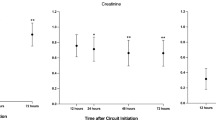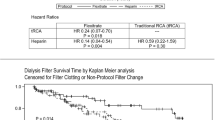Abstract
Background
Clotting of continuous renal replacement therapy (CRRT) circuits leads to inadequate clearance, decreased ultrafiltration, and increased resource use. We identified factors associated with premature clotting of circuits during CRRT in children.
Methods
In a retrospective cohort of 26 children (median age 11.8 years) receiving 79 CRRT circuits (51 heparin, 22 citrate, 6 using no anticoagulation), we captured hourly pressure, flow, and fluid removal rates along with all activated clotting time (ACT) and circuit ionized calcium measurements. Cox and logistic regression models were used to examine factors associated with premature circuit clotting before the scheduled 3-day circuit change.
Results
Of the 79 circuits, 51 (64.6%) underwent unplanned filter change due to filter clotting (median duration 18.25 h, interquartile range [IQR] 9.25, 33.5 h), and 28 (35.4%) underwent scheduled change (median duration 66 h, IQR 61.00, 69.00 h). Patient age, catheter size and location, blood flow rate, and the percentage of pre-filter replacement fluid were not associated with premature clotting. Heparin circuits were less likely than citrate circuits to clot prematurely. Each 1-mmHg increase in the transmembrane or filter pressure was independently associated with a 1.5% (95% confidence interval [CI] 1.0–2.0%) and 1.5% (95% CI 1.0–2.0%) higher risk of clotting, respectively. Higher ACTs were associated with lower transmembrane (p = 0.03) and filter (p < 0.001) pressures.
Conclusions
The majority of circuits in our cohort were subject to unplanned filter changes. Elevated transmembrane and filter pressures were associated with clotting. Our results suggest that maintaining higher ACT may decrease the risk of circuit clotting. Larger studies are needed to examine other factors that may prolong the lifespan of the CRRT circuit in this high-risk population.



Similar content being viewed by others
References
Fortenberry JD, Paden ML, Goldstein SL (2013) Acute kidney injury in children: an update on diagnosis and treatment. Pediatric Clin North Am 60(3):669–688
Sutherland SM, Alexander SR (2012) Continuous renal replacement therapy in children. Pediatr Nephrol 27:2007–2016
Uchino S, Nigel F, Baldwin I, Morimatsu H, Bellomo R (2003) Continuous is not continuous: the incidence and impact of circuit downtime on uremic control during continuous vena-venous haemofiltration. Intensive Care Med 29:575–578
Srisawats N, Lawsin L, Uchino S, Bellomo R, Kellum JA, BEST Kidney Investigators (2010) Cost of acute renal replacement therapy in the intensive care unit: results from The Beginning and Ending Supportive Therapy for the Kidney (BEST Kidney) study. Crit Care 14(2):R46
Baldwin I, Bellomo R, Koch B (2000) Blood flow reductions during continuous renal replacement therapy and circuit life. Intensive Care Med 26:1694–1697
Holt AW, Bierer P, Bersten AD, Bury LK, Vedig AE (1996) Continuous renal replacement therapy in critically ill patients: monitoring circuit function. Anaesth Intensive Care 24(4):423–429
Joannidis M, Oudemans-van Straaten HM (2007) Clinical review: Patency of the circuit in continuous renal replacement therapy. Crit Care 11:218
Brophy PD, Somers MJ, Baum M, Symins JM, McAfee N, Firtenberry JD, Rogers K, Barnett J, Blowey D, Baker C, Bunchman TE, Goldstein SL (2005) Multi-center evaluation of anticoagulation in patients receiving renal replacement therapy (CRRT). Nephrol Dail Transplant 20:1416–1421
Soltysiak J, Warzywoda A, Kocinski B, Ostalska-Nowicka D, Benedyk A, Silska-Dittmar M, Zachwieja J (2014) Citrate anticoagulation for continuous renal replacement therapy in small children. Pediatr Nephrol 29:469–475
Fernandez SN, Santiago MJ, Lopez-Herce J, Garcia M, Del Castillo J, Alcaraz AJ, Bellon JM (2014) Citrate anticoagulation for CRRT in children: comparison with heparin. Biomed Res Int 2014:786301
Stucker F, Ponte B, Tataw J, Martin PY, Wozniak H, Pugin J, Saudan P (2015) Efficacy and safety of citrate-based anticoagulation compared to heparin in patients with acute kidney injury requiring continuous renal replacement therapy: a randomized controlled trial. Crit Care 19:91
Monchi M, Berghmans D, Ledoux D, Canivet JL, Dubois B, Damas P (2004) Citrate vs. heparin for anticoagulation in continuous venovenous hemofiltration: a prospective randomized study. Intensive Care Med 30(2):260–265
Uchino S, Fealy N, Baldwin I, Morimatsu H, Bellomo R (2003) Pre-dilution vs post-dilution during continuous veno-venous hemofiltration: impact on filter life and azotemic control. Nephron Clin Pract 94:c94–c98
Goonasekera CD, Wang J, Bunchman TE, Deep A (2015) Factors affecting circuit life during continuous renal replacement therapy in children with liver failure. Ther Apher Dial 19(1):16–22
Sutherland SM, Goldstein SL, Alexander SR (2014) The Prospective Pediatric Continuous Renal Replacement Therapy (ppCRRT) Registry: a critical appraisal. Pediatr Nephrol 29:2069–2076
Hackbarth R, Bunchman TE, Chua AN, Somers MJ, Baum M, Symons JM, Brophy PD, Blowey D, Fortenberry JD, Chand D, Flores FX, Alexander SR, Mahan JD, McBryde KD, Benfield MR, Goldstein SL (2007) The effect of vascular access location and size on circuit survival in pediatric continuous renal replacement therapy: a report from the PPCRRT registry. Int J Artif Organs 30:1116–1121
del Castillo J, Lopez-Herce J, Cidoncha E, Urbano J, Mencia S, Santiago MJ, Bellon JM (2008) Circuit life span in critically ill children on continuous renal replacement treatment: a perspective observational evaluation study. Crit Care 12:R93
Symons JM, Chua AN, Somers MJ, Baum MA, Bunchman TE, Benfield MR, Brophy PD, Blowey D, Fortenberry JD, Chand D, Flores FX, Hackbarth R, Alexander SR, Mahan J, McBryde KD, Goldstein SL (2007) Demographic characteristics of pediatric continuous renal replacement therapy: a report of the prospective pediatric continuous renal replacement therapy registry. Clin J Am Soc Nephrol 2(4):732–738
Bunchman TE, Maxvold NJ, Brophy PD (2003) Pediatric convective hemofiltration: Normocarb replacement fluid and citrate anticoagulation. Am J Kidney Dis 42(6):1248–1252
Friedman J (2001) Greedy function approximation: a Gradient Boosting Machine. Ann Stat 29(5):1189–1232
Natekin A, Knoll A (2013) Gradient Boosting Machines, a tutorial. Front Neurorobot 7:21
Tolwani A (2012) Continuous renal-replacement therapy for acute kidney injury. N Engl J Med 367:2505–2514
Baldwin I, Bellomo R (2004) Relationship between blood flow, access catheter and circuit failure during CRRT: a practical review. Contrib Nephrol 144:203–213
Ramesh Prasad GV, Palevsky PM, Burr R, Lesko JM, Gupta B, Greenberg A (2000) Factors affecting system clotting in continuous renal replacement therapy: results of a randomized, controlled trial. Clin Nephrol 53(1):55–60
Ejaz AA, Komorski RM, Ellis GH, Munjal S (2007) Extracorporeal circuit pressure profiles during continuous venovenous haemofiltration. Nurs Crit Care 2(2):81–85
Acknowledgments
Dr. Laskin is supported by grant DK101600 and Dr. Denburg by grant DK093556, both K23 Career Development Awards from the National Institutes of Health.
Author information
Authors and Affiliations
Corresponding author
Ethics declarations
The study was reviewed and approved by our Institutional Review Board who waived the requirement for informed consent.
Disclosures
Dr. Goldstein consults for and receives educational and research grant support from Baxter-Gambro Renal.
Rights and permissions
About this article
Cite this article
Kakajiwala, A., Jemielita, T., Hughes, J.Z. et al. Membrane pressures predict clotting of pediatric continuous renal replacement therapy circuits. Pediatr Nephrol 32, 1251–1261 (2017). https://doi.org/10.1007/s00467-017-3601-z
Received:
Revised:
Accepted:
Published:
Issue Date:
DOI: https://doi.org/10.1007/s00467-017-3601-z




